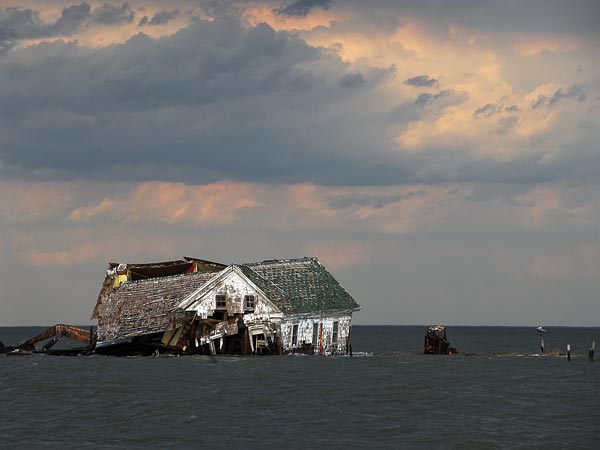Sea Levels Rising Fast on U.S. East Coast

The last house on Holland Island, Maryland, where 360 people lived before tides took over.
Sea level rise on the U.S. East Coast has accelerated much faster than in other parts of the world—roughly three to four times the global average, a new study says.
Calling the heavily populated region a sea level rise hot spot, researchers warn that cities such as Boston, New York, Philadelphia, and Baltimore could face a more flood-prone future.
Sea levels worldwide are expected to rise as global warming melts ice and causes water to expand. Those levels, though, are expected to vary from place to place, due to factors such as ocean currents, differences in seawater temperature and saltiness, and the Earth’s shape.
Now it seems scientists have pinpointed just such a variance.
Analyzing tide-level data from much of North America, U.S. Geological Survey scientists unexpectedly found that sea levels in the 600-mile (1,000-kilometer) stretch of coast from Cape Hatteras (map), North Carolina, to the Boston area climbed by about 2 to 3.8 millimeters a year, on average, between 1950 and 2009.
Global sea level rise averaged about 0.6 to 1 millimeter annually over the same period.
“If you talk with residents of this hot spot area in their 70s or 80s who’ve lived there all their lives, they’ll tell you water is coming higher now in winter storms than it ever did before,” said study co-author Peter Howd, an oceanographer contracted with the USGS.
“We’re now finally getting to the point where we can measure their observations with our highfalutin scientific instruments.”
Flood of Data
At New York City, the team extrapolated, sea levels could rise by 7.8 to 11.4 inches (20 to 29 centimeters) by 2100—in addition to the roughly 3 feet (1 meter) of average sea level rise expected worldwide by then.
For residents of New York and cities up and down the eastern seaboard, those numbers should become a lot more than ink on paper.
“The first thing people will see from this is an increase over the next few decades in the low-level coastal flooding that occurs now with wintertime storms,” Howd said.
“Eventually you’ll see coastal flooding events three to four times a year instead of once every three to four years.”
But it’s not just cities that are expected to suffer.
“The northeast coast of the U.S. is flat,” said climate modeler Jianjun Yin at the University of Arizona, who did not participate in this research. “Even gradual sea level rise could cause rapid retreat of shoreline and significant loss of wetland habitats.”
Mysteries of East Coast Sea Level Rise
It’s still something of a mystery why the U.S. East Coast is bearing the brunt of sea level rise. Maybe, the researchers say, fresh water from Greenland’s melting ice is disrupting North Atlantic currents, slowing the Gulf Stream and causing East Coast sea levels to rise.
It’s also unclear to what extent humans may be to blame.
“This could be part of a natural cycle maybe 100 to 200 years long. Or not,” study ao-author Howd said. “We need more data over years to help build climate models and greater understanding.”
The team cautions too that the East Coast may not be alone.
“We’re now looking into extending our analysis to see if hot spots in sea level rise show up in other places around the globe,” said USGS oceanographer Kara Doran, who co-authored the study, published June 24 by the journal Nature Climate Change.
Nothing to See Here?
The new findings come at a particularly interesting political moment in one of the states in the sea level hot zone.
Concerned over regulations that could result from recent sea level rise forecasts, some North Carolina legislators have drafted a bill requiring that future state sea level forecasts be based on only past patterns.
“Trying to ban the use of the best science for sea level predictions is absurd,” said University of Pennsylvania coastal geologist Ben Horton, who wasn’t part of the new study.
NASA climate scientist Josh Willis agreed, adding that such efforts “are sort of a case of human nature trying to outwit Mother Nature, and Mother Nature usually wins that battle of wits.
“It’s really shortsighted to assume that the next hundred years of sea level rise are going to be like the last hundred years,” Willis added. “We’re already seeing glaciers and ice sheets melt more quickly, and the ocean absorbing more heat and expanding—things that drive sea level rise.”
You can return to the main Market News page, or press the Back button on your browser.

